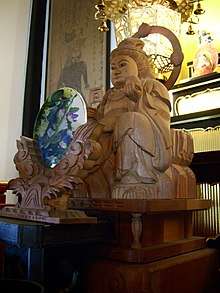Dai Gohonzon
The Dai Gohonzon of the High Sanctuary of the Essential Teachings, commonly known as the Dai Gohonzon (Japanese: 大 御 本 尊 The Supreme (Great) Gohonzon or Honmon Kaidan Dai Gohonzon, Japanese: 本 門 戒 壇 の 大 御 本 尊) is a venerated calligraphic mandala image inscribed with Sanskrit and Chinese characters on a plank of Japanese camphorwood.
| The Dai Gohonzon of the High Sanctuary of the Essential Teachings | |
|---|---|
| Japanese: 大 御 本 尊, English: Dai Gohonzon An early photograph of the mandala at Head Temple Taiseki-ji, as printed in Kumada Ijo's 1913 book titled Nichiren Shonin. | |
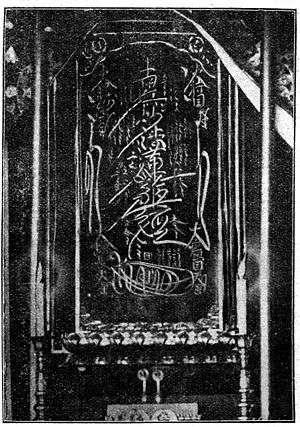 | |
| Artist | Nichiren Daishonin (ink scribed) Nippo Shonin (carved to) |
| Year | 12 October 1279 |
| Type | Woodcarving plaque |
| Medium | Japanese Camphorwood |
| Dimensions | 143.5 cm × 65.02 cm (56.5 in × 25.60 in) |
| Location | Taiseki-ji Temple complex, Hoando storage house, Fujinomiya, Japan |
The image is the main object of worship of the Nichiren Shōshū sect of Buddhism. The sect's priesthood claims that the image was painted by Nichiren on wood, then carved by his artisan disciple Izumi Ajari Nippo. However, according to published scholarly sources, the image was first mentioned in an official document issued by the ninth High Priest Nichiu Shonin (1409–1482).[1]
The High Priests of Nichiren Shoshu copy and transcribe their own rendition of the image, which is then distributed to the sect's followers. Due to its hallowed status within the sect, the image can only be viewed by Hokkeko group members.
Buildings at Taiseki-ji in the Fujinomiya area of Japan that have housed the Dai Gohonzon are the Shimonobo (1290), the Mutsubo (1332), the Gohozo (1717), the Hoanden (1955), the Shohondo (1978), and the Hoando (2002).
Etymology
The Japanese meanings note:
- 大 — Dai means "Great" or "Supreme”
- 御 — Go means “Majestic” or “Sacred”
- 本 尊 — Honzon means “Object of Worship”."
Description
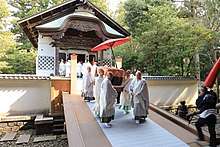
The Dai Gohonzon is a wooden plank, composed of fragrant Japanese camphorwood believed to be inscribed by Nichiren Daishonin and rendered into wood by Nippo Shonin. The image measures approximately 56.6 inches by 25.6 inches. It is coated in black urushi with gilded characters composed of grounded 24k karat gold dust. The bottom portion features the great Zo-han personal signature seal of Nichiren. It features a semi-rounded backing cage and rippled textured surface coated with urushi lacquer. Carved on the image are names of Buddhas, Buddhist and Indian gods along with mystical creatures representing the “Treasure Tower” of the Lotus Sutra which is also claimed to possess and imbue the eternalized life and legacy of Nichiren himself.
The image is said to have two inscriptions, the words "Ya-Shiro-Kunishige-Hon-Mon-Kai-Dan-no-Hokke-shu" (Translation: Yashiro Kunishige, for the High Sanctuary of Essential Teachings of Image of Worship of the Lotus believers) and "Ichien-Bodai-So-Yo" which refers to the bestowal of this particular Gohonzon for the entire world and its benefit.
Every year on April 6 or 7 at the O-Mushibarai ceremony, the High Priest of Nichiren Shoshu takes on the formal task of cleaning the accumulated dust on the surface of the Dai Gohonzon. The High Priest also performs the Ushitora Gongyo ceremony at the traditional time of 2:30AM.
History
Legend claims that a Tennyo goddess named Shichimen appeared before Nichiren Daishonin who at the time was reciting the Lotus Sutra in Kuonji Temple. The woman introduced herself as a water deity seeking to be absolved from past Negative Karma. Nichiren took a vase and placed it before her, revealing her identity as a red water dragon and instructed her to return to the lake and remain there to protect the Kuon Ji Temple. This same deity is claimed to have sent the log of what would become the Dai Gohonzon when Nippo Shonin wanted to carve a statue of his master, Nichiren.
According to the doctrines of Nichiren Shoshu based on the Gosho writing Jogyo-Shu-den-Sho (disputed to be apocryphal by other Nichiren sects), the image was from the original Gohonzon made by Nichiren himself, and transferred into wood by Nippo Shonin, one of his disciples. Nippo underwent immense fasting and prayer to the dragon goddess Shichimen, the patroness of Yamanashi prefecture. The goddess answered his prayer by sending a log in a nearby river. Once stored in the Kuon-ji temple in Yamanashi Prefecture, the image was later confiscated by Nikko Shonin, who designated his strongest disciple, Hyakken-bo to carry the image on his backside through the forest into the Taisekiji complex, where it remains today.
"Nippo (disciple) wanted to carve a statue of Nichiren. He then prayed to (Goddess) Shichimen Dai-myo-jin. Was it an answer (Kannu) to his prayers? He found a log floating in the (river).[2]
The priesthood of Nichiren Shoshu claims that due to the incompleteness of the altar of the Dai Gohonzon, it is not enshrined with Japanese Shikimi evergreen plants nor Taiko drums. In addition, they believe that the Dai Gohonzon should not be exposed for public view until kosen-rufu is achieved, primarily referring to Nichiren Shoshu becoming the main religion on the planet.
The twenty-sixth High Priest, Nichikan Shonin, declared in his treatise Kan-jin-no-Honzon-Sho (The Verified Object of Worship) the following regarding the image: {{Quote|The Gohonzon of the High Sanctuary of the Essential Teaching, inscribed in the second year of Koan (1279), is the ultimate, the absolute, and the final cause of the Daishonin's advent. It is the greatest among the Three Great Secret Laws and the supreme object of worship in the entire world. (Mondan-shu, pp. 197)
The Nichiren Shōshū sect of Nichiren Buddhism claim that Nichiren inscribed the Dai Gohonzon on the twelfth day of the tenth month, 1279 (Japanese: Ko-an). Nichiren Shōshū adherents cite a passage in Nichiren's 'On Persecutions Befalling the Sage' that they assert supports the authenticity of the Dai Gohonzon. The passage reads:
The Buddha fulfilled the purpose of his advent in a little over forty years, the Great Teacher T'ien-t'ai took about thirty years, and the Great Teacher Dengyo, some twenty years. I have spoken repeatedly of the indescribable persecutions they suffered during those years. For me it took twenty-seven years, and the great persecutions I faced during this period are well known to you all.
However, this passage doesn't mention a Gohonzon or any mandala, and no original document exists in which Nichiren mentioned a Dai Gohonzon.[3][4]
According to the Nichiren sects around Mount Fuji
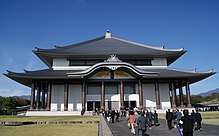
The Fuji Branch, sometimes referred to as the Fuji School, refers to the Nichiren Buddhist denominations stemming from Nichiren's disciple Nikkō. These schools believe that Nichiren inscribed the Dai Gohonzon, a Gohonzon unique to the Fuji Branch schools.
The Fuji Branch believes that in the autumn of 1279, a number of Nichiren's laypeople in the Fuji District were targeted by Gyōchi[5] (行智), the chief priest of a temple where Nisshū (日秀), one of Nichiren's disciples, lived. The believers, uneducated peasant farmers from the village of Atsuhara, had come to help Nisshū with the harvest of his private rice crop. A peasant named Gyōchi called some local warriors to arrest the peasants, accusing them of illegally harvesting the rice. The peasants decided to defend themselves when the warriors arrived but were no match, and several were wounded; twenty were arrested and hauled off to Kamakura for trial. When they arrived, a local mercenary Hei no Saemon attempted to intimidate the peasants into renouncing their faith — on pain of death if they did not, but in exchange for their freedom if they did. Despite repeated threats and even torture, they remained steadfast. Hei no Saemon had three beheaded, but the other 17 refused to back down and he eventually freed them. The Fuji Branch believes that these events took place on 15 October 1279.
The Fuji Branch believes that Nichiren, observing from his disciples' reports, reveals the Gohonzon that he intended to fulfill the purpose of his advent in this world (出 世 の 本 懐 shusse-no-honkai). On 12 October 1279, he inscribed the Gohonzon known as the "Dai Gohonzon," which – in contrast to other Gohonzon inscribed in this period – is intended for worship by all his disciples and believers, contemporary and future, rather than just the specific individual named on it.
Multiple Dai Gohonzon mandalas
The records of Taiseki-ji temple show there have been at least four different sizes of Dai Gohonzon in the possession of the Nichiren Shoshu sect, indicating that the current Dai Gohonzon is just one of several reproductions made over time after fires at Taiseki-ji destroyed previous copies. The most notable and significant size changes after fire outbreaks have been recorded in the years 1600 (measuring 1515mm x 727mm), the year 1764 (measuring 1439mm x 651mm), the year 1911 (measuring 1410mm x 660mm) and the current Dai Gohonzon (measuring 1680mm x 675mm), which was commissioned by the 67th High Priest of Nichiren Shoshu.[6]
In addition to the Nichiren Shoshu sect, other Dai Gohonzon are in the possession of Nichiren Shu sect and of the Fujisan Honmon Shoshu sect. At the Kitayama Honmonji temple of Nichiren Shu sect, located in Omosu, Suruga Province of Japan, there is another Dai Gohonzon inscribed by Nichiren. The Kitayama Honmonji temple is also the grave site of Nikkō Shōnin, a disciple of Nichiren who is regarded as the founder of Kitayama Honmonji temple.[7]
The Fujisan Honmon Shoshu sect in Kamakura city in Kanagawa Prefecture also claims possession of a Dai Gohonzon inscribed by Nichiren, which they refer to as the Dai-Honzon. The Dai-Honzon is the main Object of Devotion of Fujisan school. It is enshrined at Hota Myohonji Temple. This mandala carries the inscription of The Great Object of Worship to Save and Protect for Ten Thousand Years and carries a signature of Jogyo Nichiren.[8][9]
Claims of forgery
Academic researchers as well as the sects of Nichiren Shu dismiss the Dai Gohonzon image as falsified, citing analysis of the calligraphy style, and that no letter by Nichiren mentions a Dai Gohonzon. In fact, the image isn't mentioned in any historical records until the 9th High Priest Nichiu Shonin (1409-1482).[10][11][12][13][14]
Various researchers have also analyzed the proportions and calligraphy styles of the Dai Gohonzon image compared with all other existing Gohonzon that were inscribed by Nichiren in the year 1279. These analysis results show that the Dai Gohonzon image is not consistent with any other Gohonzon that Nichiren inscribed in 1279. Scholar-priest Kaiso Inada is one such modern researcher. Inada lived from 1869 to 1956, and was a colleague of the Nichiren Shoshu high priest Hori Nichiko. Inada recorded that he was granted lodging at Taiseki-ji and was able to examine the Dai Gohonzon image and other Nichiren mandalas that may have been used as a matrix for its creation. His conclusion was that the Dai Gohonzon stored at Taiseki-ji was created using different sheets traced from at least two other Nichiren mandalas.[15]
Places of former storage and enshrinement
The Dai Gohonzon image is currently in the possession of the Nichiren Shōshū priesthood. They claim that Nikko Shonin brought it to the Mutsubo, and it was stored at the Shimonobo temple in Fujinomiya, at the historical residence of Nanjo Tokimitsu, the land donor of the present Taisekiji Temple. Later it was enshrined in the Great Kaidan hall as well as the Gohozo treasury building of Taisekiji. In October 1972, the image was enshrined in the Shohondo building funded by Nichiren Shoshu members, Soka Gakkai members, Kempon Hokke Shu believers, and family relatives of Nichiren Shoshu temple priests. The building was demolished in 1998.
The image was removed from the Sho-Hondo building in April 1998 and was temporarily stored in the Go-Hozo treasure house. The image is presently housed in the Shumidan (English: Mount Sumeru) high altar within the Hoando building of Taisekiji, which contains 5,004 reserved seats for Nichiren Shoshu lay followers, 236 Tatami mats for priests, and a center chair for the High Priest of Nichiren Shoshu.
Gallery of transcriptions
 An obscure photo of the enshrined Dai Gohonzon in the Go-ho-zo Kaidan building in Taisekiji. Photo by Kokichi Yui. Circa 1915.
An obscure photo of the enshrined Dai Gohonzon in the Go-ho-zo Kaidan building in Taisekiji. Photo by Kokichi Yui. Circa 1915. A Gohonzon Mandala transcribed by Nikko Shonin, the 2nd High Priest of Nichiren Shoshu.
A Gohonzon Mandala transcribed by Nikko Shonin, the 2nd High Priest of Nichiren Shoshu. A transcribed copy of the Dai Gohonzon by the 35th High Priest of the Head Temple, Nichi-on Shonin from the year 1765.
A transcribed copy of the Dai Gohonzon by the 35th High Priest of the Head Temple, Nichi-on Shonin from the year 1765. A Gohonzon Mandala transcribed by Nichiden Shonin, the 52nd High Priest of Nichiren Shoshu.
A Gohonzon Mandala transcribed by Nichiden Shonin, the 52nd High Priest of Nichiren Shoshu. A Gohonzon Mandala transcribed by Nippu Shonin, the 55th High Priest of Nichiren Shoshu.
A Gohonzon Mandala transcribed by Nippu Shonin, the 55th High Priest of Nichiren Shoshu. A Gohonzon Mandala transcribed by Nichi-O Shonin, the 56th High Priest of Nichiren Shoshu.
A Gohonzon Mandala transcribed by Nichi-O Shonin, the 56th High Priest of Nichiren Shoshu. A Gohonzon Mandala of year 1728 as transcribed by Nichikan Shonin, the 26th High Priest of Nichiren Shoshu, authorized by 60th High Priest Nichikai Shonin in 1942. Currently enlarged and reproduced by Kenshokai organization.
A Gohonzon Mandala of year 1728 as transcribed by Nichikan Shonin, the 26th High Priest of Nichiren Shoshu, authorized by 60th High Priest Nichikai Shonin in 1942. Currently enlarged and reproduced by Kenshokai organization. A Gohonzon Mandala transcribed in 13 July 1720 by Nichikan Shonin, 26th High Priest of Nichiren Shoshu, presently altered and reproduced by Soka Gakkai.
A Gohonzon Mandala transcribed in 13 July 1720 by Nichikan Shonin, 26th High Priest of Nichiren Shoshu, presently altered and reproduced by Soka Gakkai. A Gohonzon Mandala transcribed by Nichikai Shonin, the 60th High Priest of Nichiren Shoshu.
A Gohonzon Mandala transcribed by Nichikai Shonin, the 60th High Priest of Nichiren Shoshu. A Gohonzon Mandala transcribed by Nikkyo Shonin, the 62nd High Priest of Nichiren Shoshu.
A Gohonzon Mandala transcribed by Nikkyo Shonin, the 62nd High Priest of Nichiren Shoshu. A Gohonzon Mandala as transcribed by Nissho Shonin, the 64th High Priest of Nichiren Shoshu, on 19 May 1951.
A Gohonzon Mandala as transcribed by Nissho Shonin, the 64th High Priest of Nichiren Shoshu, on 19 May 1951. A Gohonzon Mandala transcribed by Nichijun Shonin, the 65th High Priest of Nichiren Shoshu.
A Gohonzon Mandala transcribed by Nichijun Shonin, the 65th High Priest of Nichiren Shoshu.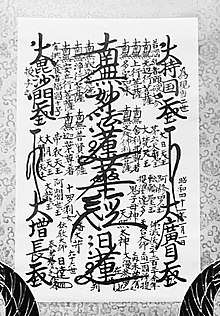 A Gohonzon Mandala transcribed by Nittatsu Hosoi Shonin, the 66th High Priest of Nichiren Shoshu.
A Gohonzon Mandala transcribed by Nittatsu Hosoi Shonin, the 66th High Priest of Nichiren Shoshu.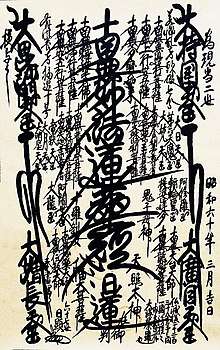 A Gohonzon Mandala transcribed on 8 March 1985 by Nikken Ajari Shonin, the 67th High Priest of Nichiren Shoshu.
A Gohonzon Mandala transcribed on 8 March 1985 by Nikken Ajari Shonin, the 67th High Priest of Nichiren Shoshu. A Gohonzon Mandala transcribed by Nichi-Nyo Shonin, the 68th High Priest of Nichiren Shoshu.
A Gohonzon Mandala transcribed by Nichi-Nyo Shonin, the 68th High Priest of Nichiren Shoshu. The Shishinden Gohonzon, a Nichiren-inscribed Gohonzon dated 3 March 1280, designated to be given to the future Emperor of Japan for preservation. Two certified copies are kept at Yoboji Temple Kyoto and at Myohoji Temple in Akita while the original is kept at Taisekiji temple.
The Shishinden Gohonzon, a Nichiren-inscribed Gohonzon dated 3 March 1280, designated to be given to the future Emperor of Japan for preservation. Two certified copies are kept at Yoboji Temple Kyoto and at Myohoji Temple in Akita while the original is kept at Taisekiji temple.
Sources
- Nichiren Mandala Study Workshop
- The Writings of Nichiren Daishonin, Soka Gakkai, 1999 (available online here.)
- The Life of Nichiren Daishonin. Kirimura, Yasuji. Nichiren Shoshu International Centre, 1980
Note: NSIC, publisher of this work, is no longer associated with Nichiren Shoshu and is now affiliated with Soka Gakkai.
Notes
- Daniel B. Montgomery: Fire in The Lotus. Mandala 1991, page. 171.
- Nippo Den (English: The Biography of Nippo), Fuji Seiten Press, pps. 731-732
- Daniel B. Montgomery: Fire in The Lotus. Mandala 1991, page. 171.
- The Honmon Kaidan Daigohonzon (2015). The Mandala in Nichiren Buddhism (PDF). The Nichiren Mandala Study Workshop. p. 16.
- Stone, Jacqueline I. (2014). The Atsuhara Affair: The Lotus Sutra, Persecution, and Religious Identity in the Early Nichiren Tradition, Japanese Journal of religious Studies 41 (1), 160-162
- The Honmon Kaidan Daigohonzon (2015). The Mandala in Nichiren Buddhism (PDF). The Nichiren Mandala Study Workshop. p. 9.
- The Honmon Kaidan Daigohonzon (2015). The Mandala in Nichiren Buddhism (PDF). The Nichiren Mandala Study Workshop. p. 10.
- The Honmon Kaidan Daigohonzon (2015). The Mandala in Nichiren Buddhism (PDF). The Nichiren Mandala Study Workshop. p. 17.
- "Nichiren Shonin Gohonzon Shu". Archived from the original on 2012-03-20. Retrieved 2020-06-23.
- Montgomery, Daniel (1991). Fire in the Lotus, The Dynamic Religion of Nichiren, London: Mandala, ISBN 1852740914, page 171
- "Questions and Answers about the Dai-Gohonzon". Archived from the original on 2012-03-23.
- "The Taisekiji Dai-Gohonzon Myth".
- "Where is Nichiren’s Reference to the Dai Gohonzon?" Archived 2007-11-02 at Archive.today Evers, Hope. December 9, 2005. Retrieved July 11, 2007
- The Honmon Kaidan Daigohonzon (2015). The Mandala in Nichiren Buddhism (PDF). The Nichiren Mandala Study Workshop. p. 8.
- The Honmon Kaidan Daigohonzon (2015). The Mandala in Nichiren Buddhism (PDF). The Nichiren Mandala Study Workshop. p. 3.
